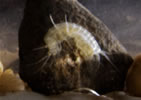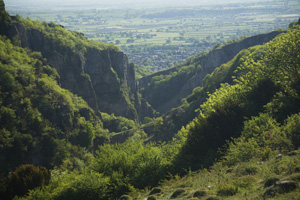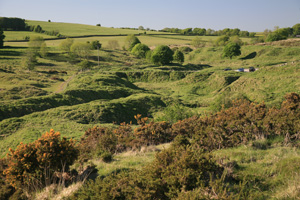The Mendip Hills consist of four large domes (periclines) thrust up above the surrounding lowlands and running along a roughly east-west axis. The tops of these domes have then been reduced by subsequent erosion of the landform, such that they are now local elevations, known as (east to west) Beacon Hill, Pen Hill, North Hill and Blackdown, the highest point at 325m. Several well defined valleys have been incised into the plateau, the most spectacular of which are Cheddar Gorge, Ebbor Gorge and Burrington Combe. Mendip caves are typically steep sloping in character but are generally quite shallow in depth (seldom deeper than 150m) and not particularly long, rarely exceeding a few kilometres in length.
The caves on Mendips can be split up into several areas, described from west to east along the plateau.
Several old relict caves occur on western Mendip, all of which are quite small, the largest being Shute Shelve Cavern (247m in length) on Axbridge Hill. On the western side of Banwell Hill are the Banwell Bone and Banwell Stalactite caves. The former was named after the numerous animal bones it contained when discovered, whilst the latter was open as a show cave for a while. There are several small adits and caves on Sandford Hill, the largest of which is Mangle Hole.
On the northern side of Blackdown lies the valley of Burrington Combe, which contains several shortish caves popular with novices, including Goatchurch Cavern, Sidcot Swallet and Aveline’s Hole, famous for its archaeological finds.
On the southern side of Blackdown, the spectacular Cheddar Gorge contains mostly small caves, with the two largest, Gough’s and Cox’s being developed as show caves. The River Yeo flows through a series of phreatic passages, discovered by divers in 1985, beneath the show cave section of Gough’s Cave.
Above the gorge, the Charterhouse area contains several popular caves, including Longwood Swallet, Charterhouse Cave, Tyning’s Barrows Swallet, Rhino Rift, Manor Farm Swallet, Upper Flood Swallet and GB Cave. GB Cave is almost 2km long and 135m deep and the impressive Gorge Passage and Main Chamber together form the largest continuous void under Mendip. Rhino Rift is an anomaly amongst Mendip caves being rather vertical in character, more like a Yorkshire pothole and makes a good SRT trip. The recently extended Upper Flood Swallet is the longest cave in the area at over 3km.
The area around North Hill includes several major systems and other smaller caves, near the village of Priddy. Swildon’s Hole is the longest cave on Mendips, with over 9km of passage, including a major streamway and several other fossil passages. St. Cuthbert’s Swallet is the second longest cave at 6.7km and contains numerous vadose canyons, developed either side of a plunging anticline that unite into a single phreatic streamway. This cave is renowned for its many fine formations and passages. The third large system in the area is Eastwater Cavern (2.5km). The water from the caves in this area drains to the south of Priddy, into Wookey Hole in the Ebbor Gorge. Wookey Hole is a 3.6km long resurgence cave and is the source of the River Axe, which flows through a series of phreatic loops, up to 90m deep in the Carboniferous Limestone, before emerging into the cave, which is unusual in that it is formed in Triassic Dolomitic Conglomerate. The first part of the cave has been developed as a show cave, whilst most of the rest of the cave is only accessible by divers. The River Axe drains much of central Mendip, including most of the caves in the Priddy area.
North of Priddy there are relatively few known caves in the Harptree area, the largest of which Lamb Leer (640m) contains one of the largest chambers on Mendip, the impressive domed Great Chamber.
Several small streams draining the sandstone on the west side of Beacon Hill sink underground on meeting the limestone near Croscombe forming several caves in the area, the largest of which is Thrupe Lane Swallet, similar to Rhino Rift in that it is rather vertical in nature.
There are no large caves on eastern Mendip, although streams draining the eastern flank of Beacon Hill have formed a few systems as they flow off the sandstone on to the limestone, close to Stoke St. Michael. The largest of these is Stoke Lane Slocker at over 2km long. In Fairy Cave Quarry, quarrying intersected several caves, including two very well decorated passages, the Shatter and Withyhill Caves, which together with the four neighbouring caves make a total of 4.5km of passage in the Fairy Cave system.
Other outlying cave systems in the Somerset area (mentioned in “Mendip Underground”) include: Holwell Cavern, in Devonian Limestone in the Quantock Hills near Taunton; Quaking House Cave in the Brendon Hills; Pen Park Hole at Southmead in Bristol; the Bath Stone mines to the south and east of Bath; and the large complex of Box Freestone quarries at Box in Wiltshire.
During the last ice (ending around 10 000 years ago) Somerset, along with the rest of southern England fared better than further north and was not glaciated, although conditions were still very cold, with sub-glacial tundra being present, similar to modern day Siberia. Much of the life eked out a precarious existence or moved to warmer climes via the land bridge that still linked the south eastern part of England to the near continent. It is possible that some organisms survived the Ice Age by living deep underground where the temperature was above freezing, but food would have been a major difficulty. Organisms that survive underground for generations will often have adaptations to help them survive, and will lose some features that are of no benefit e.g. use of eyes. Those that were adapted to life underground become troglobites - cave dwellers that complete their life cycle in the cave and do not exist outside of this environment. These are the most fascinating creatures you will see underground, but they are also part of a delicate ecosystem that is easily disturbed by cavers and other human activities on the surface.
The creatures found in caves can be classified according to how much of their life cycle they spend in the cave and how dependant they are on the cave environment.
Troglophile: can successfully complete its life cycle both in and out of the cave environment.
Troglobite: cannot complete life cycle outside of the cave environment. These have morphological adaptations to the cave environment e.g. blind, longer legs, lower metabolic rate.
Cavernicole: a more general term for a creature that lives in a caves and can complete its life cycle there, but may also live in other dark habitats e.g. soil, under stones, bark.
As many of our troglobites have only been underground since the last Ice Age they have not had time to evolve some of the bizarre adaptations seen abroad, where cave life has been unaffected by such catastrophes for much longer.
|



